This purchase only includes chapter 6 of this title.
Abstract
As part of the 4th Global Botanic Garden Congress in Dublin, Ireland (2010), six gardens (Fairylake BG, JBC, LNBG, MBC, NYBG, and Orto Botanico) convened a Cycad Collections in Botanic Gardens symposium highlighting their main research topics, cultivation, collections, and challenges. This talk summarizes the consensus produced from that symposium. Most public botanic gardens hold cycads as display plants in landscaping exhibits or glasshouses. Given specific circumstances of long generation times, limited number of taxa, small population sizes, and in situ conservation threats, these botanic garden cycads are an increasingly important resource. The focus and structure of collections are diverse: Some gardens hold comprehensive cycad collections for purposes of ex situ conservation and research; some hold comprehensive regional collections for general horticulture, taxonomy, and systematic research yet others hold comprehensive cycad DNA collections and data; and others hold historical collections of both old and new world cycads where cycad research is ongoing since the 19th century. Considering Botanic Gardens Conservation International (BGCI)’s successful Plant Search database system connecting researchers looking for material, it was suggested that a consortium be formed to share valuable information on the maintenance of collections, cultivation, research, educational programs as well as security problems peculiar to cycads. Close contact between gardens will encourage the exchange of material, information, and collaborative advances. We highlight here how research outcomes at these gardens benefit from integrating expertise, resources, and assets internationally. We also present a draft of the consortium mission. The invitation is open to other botanic gardens that hold cycad collections for research.
Keywords: conservation, in situ, living collections, ex situ











